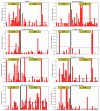Gut Dysbiosis and Hemodynamic Changes as Links of the Pathogenesis of Complications of Cirrhosis
- PMID: 37764046
- PMCID: PMC10537778
- DOI: 10.3390/microorganisms11092202
Gut Dysbiosis and Hemodynamic Changes as Links of the Pathogenesis of Complications of Cirrhosis
Abstract
The aim was to evaluate the relationship between gut dysbiosis and hemodynamic changes (hyperdynamic circulation) in cirrhosis, and between hemodynamic changes and complications of this disease. This study included 47 patients with cirrhosis. Stool microbiome was assessed using 16S rRNA gene sequencing. Echocardiography with a simultaneous assessment of blood pressure and heart rate was performed to assess systemic hemodynamics. Patients with hyperdynamic circulation had more severe cirrhosis, lower albumin, sodium and prothrombin levels, higher C-reactive protein, aspartate aminotransferase and total bilirubin levels, and higher incidences of portopulmonary hypertension, ascites, overt hepatic encephalopathy, hypoalbuminemia, hypoprothrombinemia, systemic inflammation, and severe hyperbilirubinemia than patients with normodynamic circulation. Patients with hyperdynamic circulation compared with those with normodynamic circulation had increased abundance of Proteobacteria, Enterobacteriaceae, Bacilli, Streptococcaceae, Lactobacillaceae, Fusobacteria, Micrococcaceae, Intestinobacter, Clostridium sensu stricto, Proteus and Rumicoccus, and decreased abundance of Bacteroidetes, Bacteroidaceae, Holdemanella, and Butyrivibrio. The systemic vascular resistance and cardiac output values correlated with the abundance of Proteobacteria, Enterobacteriaceae, Bacilli, Streptococcaceae, Lactobacillaceae, Micrococcaceae, and Fusobacteria. Heart rate and cardiac output value were negatively correlated with the abundance of Bacteroidetes. The mean pulmonary artery pressure value was positively correlated with the abundance of Proteobacteria and Micrococcaceae, and negatively with the abundance of Holdemanella.
Keywords: gut–heart axis; gut–liver axis; microbiome; microbiota; portal hypertension.
Conflict of interest statement
The authors declare no conflict of interest.
Figures





References
Grants and funding
LinkOut - more resources
Full Text Sources
Research Materials

